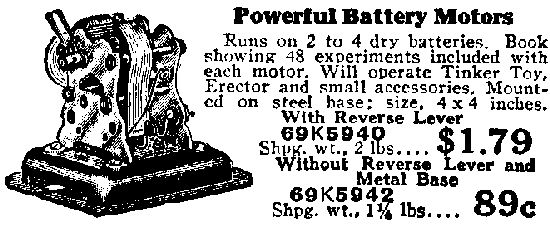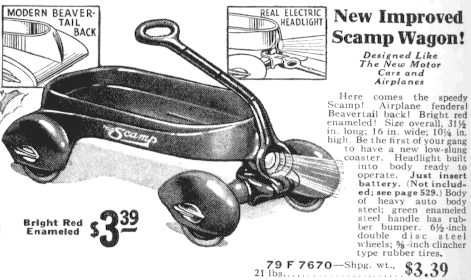Toys
Sorting through a box the other day, I found old toys -- a lead soldier, a stuffed dog, a set of blocks. In a rush, they brought back the sensate connection we feel with our childhood playthings:
The ozone smell of the electric motor for my erector set. The satisfying fit of Lincoln Logs. The liquid sound of a candle-powered, steam-propelled Put-Put boat in the bathtub. The thump of a really well-made sling-shot. The just-right tension of a windup rubber-treaded tractor. Model-airplane dope, snowballs, sleds, and my first bike. What a vast formative influence toys are!
Now I find a book of toy ad pages from the Sears and Roebuck catalog -- 1921 to 1939. The later ones are those I pored over as a child, wondering what I might talk my parents into buying for Christmas or my birthday. The book also shows how toymakers reshaped the outside world to fit the minds of children. And I trace, with fascination, how toys evolved throughout those years.
Look at construction kits: At first you find small carpentry sets. Here are the tools: you decide how to use them! But assembly kits also appear. Tinker Toys are there along with the famous metal construction kits: Meccano, Erector, and others. They compete in the beginning. Erector sets, which so touched children of my vintage, emerge as victor. Any set, even Tinker Toys, offered to sell you one of the new electric motors to drive the machines you'd built. As time passed, prices dropped and quality improved.

Then as now the catalog was filled with guns -- compressed-air popguns, cork guns, cap guns. A dollar would buy a big sturdy dump truck to use in the back yard. You could move sand to the castle you were building while you made engine noises. These trucks usually had battery-operated headlights that broke before the first battery wore out. Otherwise they were nearly indestructible.
Streamlining appeared, very suddenly, in 1934. That was the year the Chrysler Airflow came on the market. Streamlining became the new watchword in design. Tricycles, electric trains, cars, trucks, and wagons all became streamlined in a blink.

As toy manufacturing became more sophisticated, handcrafting waned. Chemistry sets, build-it-yourself crystal sets and go-carts were gradually replaced with ready-to-use toys.
The Great Depression fails to reveal itself on these pages. Here's a tricycle whose price would've bought two hundred hamburgers for the hungry unemployed your mother was feeding at the back door. These pages aren't about the economics of reality; they're about a child's dreams. Nor did it even matter that few toys lived up to the advertising copy. The catalogs showed us possibility -- while we built our own soapbox cars, pinhole cameras, and kites.
These catalogs somehow transcend the stuff they sell. For me they tell the paradoxical kinship between the base business of simply wanting and the sustaining power of hope.
I'm John Lienhard, at the University of Houston, where we're interested in the way inventive minds work.
(Theme music)
Collectible Toys and Games of the Twenties and Thirties from Sears, Roebuck and Co. Catalogs (James Spero, ed.). New York: Dover Publications, Inc., 1988. (I find it intriguing, in this context, that the name Spero means "I hope" in either Italian or Latin.)
In a recent op ed piece in the engineering education journal, engineer/historian Henry Petroski emphasizes the importance of toys: Petroski, H., Back to the Future. Prism, Vol. 9, no. 5, Jan. 2000.
And in this source, the former director of the University of Minnesota's Institute of Technology joins with his wife to bring us a study of early mechanical toys. Spilhaus, A., and Spilhaus, K., Mechanical Toys: How Old Toys Work. New York: Crown Publishers, Inc., 1989.